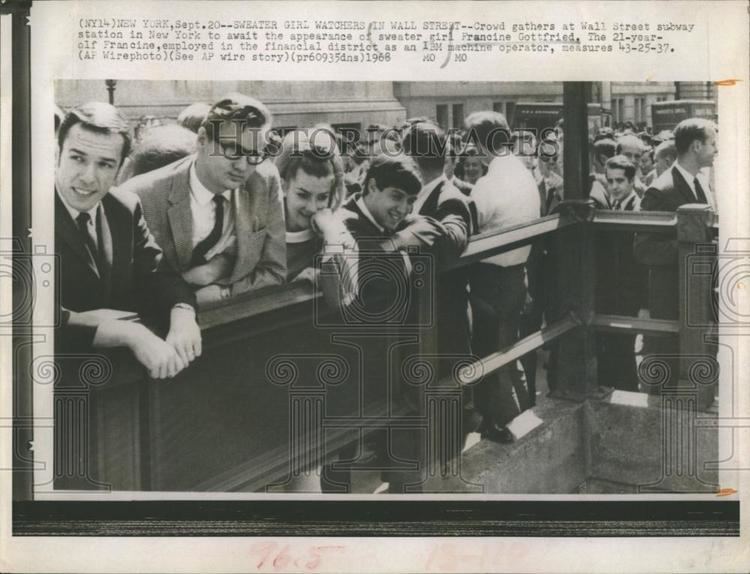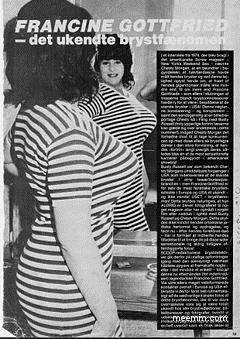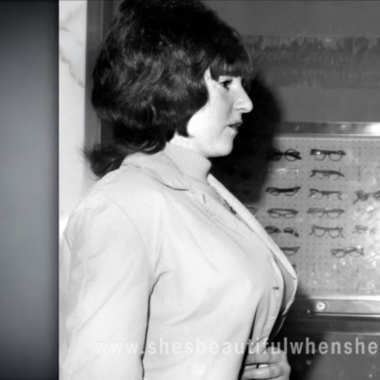Name Francine Gottfried | ||
 | ||
Francine Gottfried (born 1947) was a clerical worker in New York City's Financial District who acquired sudden brief celebrity when, in the space of two weeks in September 1968, increasing numbers of men began watching her as she walked to work. Newspapers dubbed her "Wall Street's Sweater Girl" as her curvaceous figure seemed to be the sole reason that crowds formed spontaneously around her whenever she appeared in the financial district.
Contents

Fame

Gottfried started working at Chemical Bank in the financial district on May 27, 1968. By late August, a small band of girl watchers had noticed her, and that she always followed the same route. They timed her daily arrival and started spreading the word to their colleagues and co-workers. For three weeks, the band of gawkers grew exponentially larger until on September 18 there were 2,000 people waiting for her.

By this point the crowd itself had become the phenomenon drawing the crowd, and the following day, September 19, over 5,000 financial district employees downed tools, left work and poured into the streets at 1:15 pm to watch the 5-foot 3-inch brunette exit the BMT station clad in a tight yellow sweater and miniskirt and walk to her job at the Chemical Bank New York Trust Company's downtown data processing center. Police closed the streets and escorted her through the mob, which damaged three cars as men climbed on their roofs to gain a better view. Stockbrokers and bankers leaned out of windows overlooking Wall Street to watch as trading came to a virtual halt. "Ticker tapes went untended and dignified brokers ran amok," wrote New York magazine. Photographers from all the daily papers and Life, Time, and New York snapped her picture. "A Bust Panics Wall Street As The Tape Reads 43" read a headline in the Daily News.

The following day, Friday, September 20, the corner of Wall and Broad was jammed with 10,000 spectators and press who waited for Gottfried in vain. Her boss had called and asked her to stay home to put a stop to the disturbances. A nice Jewish girl who lived at home with her parents in Williamsburg, she wasn't seeking notoriety and started taking a different route to work. "I think they're all crazy," she was quoted as saying. "What are they doing this for? I'm just an ordinary girl." On October 4, publicists took other busty women to Wall Street as rivals for Gottfried's attention: Mrs. Geri Stotts, an office manager flown in from Burbank, California by a Los Angeles radio station, and Ronnie Bell, a stripper in a New York burlesque house.
After that, the Francine mania on Wall Street quickly subsided.
Responses

Although Gottfried made it clear to interviewers that she was willing to entertain movie and modeling offers, her 15 minutes of fame were soon over and she quickly faded into obscurity. Brief accounts of the crowd-gathering phenomenon she triggered subsequently appeared in a number of sociological and pop historical books, some treating it as a survival of the so-called "bosom mania" of the 1950s. A folk song about her, slyly contrasting the crowd that went to see her with the one welcoming presidential candidate Richard Nixon nearby, was published in Broadside magazine. Artist and prankster Joey Skaggs offered a facetious show of support by hanging a 50-foot black bra opposite the stock exchange. She dined with the Apollo 10 astronauts, and Esquire awarded her a "Dubious Achievement" award, depicting her with other "dubious achievers" on the cover of the January 1970 issue. She was referenced as a cultural icon of the era in Thomas Hauser's novel Finding the Princess.
The events of September 1968 made an impression on second-wave feminists in the city, and in March 1970, they retaliated in a raid on Wall Street which they dubbed the "Ogle-In", in which a large group of feminists, including Karla Jay, Alix Kates Shulman, and a number of women who had participated in the sit-in at Ladies Home Journal a few weeks before, sexually harassed male Wall Streeters on their way to work. Susan Brownmiller reminisced in her memoir In Our Time:
"In 1970 the movement began to politicize street harassment with collective action. The Ogle-In was a popular tactic. A bunch of us would gather on a street corner and turn the tables on leering, lip-smacking men by giving them a taste of their own medicine. After the newspapers reported that a bunch of stock market employees had developed a "fun" morning ritual before work, gathering on the street to watch a particular secretary with large breasts emerge from the subway station, Karla Jay organized a retaliatory Ogle-In on Wall Street. She chose a March afternoon at lunchtime. It was incredibly liberating to reverse the wolf whistles, animal noises, and body parts appraisals that customarily flowed in our direction. Wendy Roberts, a free-spirited hippie who called herself Wendy Wonderful, was my heroine that day. She sauntered up behind an unwitting passerby and grabbed his crotch. Oh retribution!"
